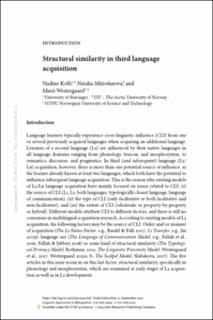Structural similarity in third language acquisition
Peer reviewed, Journal article
Published version
Permanent lenke
https://hdl.handle.net/11250/3101069Utgivelsesdato
2023Metadata
Vis full innførselSamlinger
Originalversjon
Kolb,N., Mitrofanova, N. & Westergaard, M.K.R. (2023) Structural similarity in third language acquisition. Linguistic Approaches to Bilingualism 10.1075/lab.23037.kolSammendrag
Language learners typically experience cross-linguistic influence (CLI) from one or several previously acquired languages when acquiring an additional language. Learners of a second language (L2) are influenced by their native languages in all language domains ranging from phonology, lexicon, and morphosyntax, to semantics, discourse, and pragmatics. In third (and subsequent) language (L3/Ln) acquisition, however, there is more than one potential source of influence, as the learner already knows at least two languages, which both have the potential to influence subsequent language acquisition. This is the reason why existing models of L3/Ln language acquisition have mainly focused on issues related to CLI: (i) the source of CLI (L1, L2, both languages, typologically closest language, language of communication), (ii) the type of CLI (only facilitative or both facilitative and non-facilitative), and (iii) the extent of CLI (wholesale or property-by-property or hybrid). Different models attribute CLI to different factors, and there is still no consensus in multilingual acquisition research. According to existing models of L3 acquisition, the following factors may be the source of CLI: Order and/or manner of acquisition (The L2 Status Factor, e.g., Bardel & Falk 2007; L1 Transfer, e.g., Jin 2009), language use (The Language of Communication Model, e.g., Fallah et al., 2016; Fallah & Jabbari 2018) or some kind of structural similarity (The Typological Primacy Model, Rothman, 2015; The Linguistic Proximity Model, Westergaard et al., 2017; Westergaard 2021a, b; The Scalpel Model, Slabakova, 2017). The five articles in this issue zoom in on this last factor, structural similarity, specifically in phonology and morphosyntax, which are examined at early stages of L3 acquisition as well as in L3 development.

